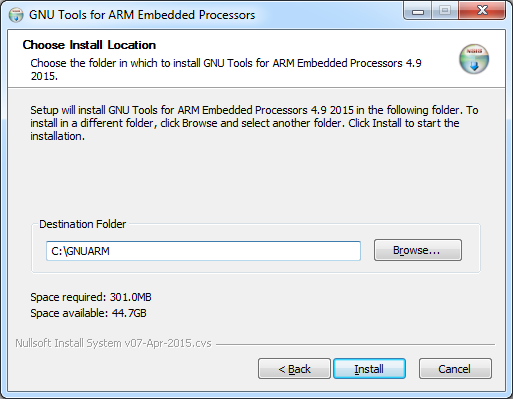Installing Gnu Arm On Cygwin X
Installing Gnu Arm On Cygwin Xp
Start Programming C with raspberry Pi. This set of instructions won't suit everybody but I'll try to be as generic as possible.
- That can be done but let's learn to walk first and learn how to compile and run programs on the Raspi. Read up on Cygwin and MinGW. GUI or Terminal.
- Extend your 50g with C - Part 1. Introduction. This lengthy article explains why you would and how you can extend the functionality of your 50g using C.
- Using this site ARM Forums and knowledge articles Most popular knowledge articles Frequently asked questions How do I navigate the site?
I installed the Debian Squeeze distribution, so the programming tutorials are based on that. Initially, I'm starting off by compiling programs on the Raspi but given its relative slowness to any PC in the last ten years, it's probably best to switch to developing on another PC and copying the executables over.
I'll cover that in a future tutorial, but for now it's about compiling on the Raspi. Preparing for Developing. The starting point is you have a Raspi with a working distribution. In my case it's Debian Squeeze which I burnt with instructions from the RPI Easy SD Card Setup. Make sure you bookmark the Wiki as it's got tons of useful stuff. If your Raspi has booted and you've logged in (username pi, p/w = raspberry) then type gcc - v at the command line. You'll see something like this: Using built- in specs.
Installing Gnu Arm On Cygwin X Windows
Target: arm- linux- gnueabi. Configured with: ./src/configure - v - -with- pkgversion='Debian 4. README. Bugs- -enable- languages=c,c++,fortran,objc,obj- c++ - -prefix=/usr - -program- suffix=- 4. Thread model: posixgcc version 4. Debian 4. 4. 5- 8)Install Samba.

One of the first things I did and recommend to you if you have a Windows PC on the same network as your Raspi is to install and setup Samba so you can access the Raspi. Then I issued this command: gcc - v > & l. To get the above listing into the file l. I could view and copy on my Windows PC. Even if you are compiling on the Raspi, you can edit source code from your Windows box and compile on the Raspi.
The database recognizes 1,746,000 software titles and delivers updates for your software including minor upgrades. SageMath (previously Sage or SAGE, "System for Algebra and Geometry Experimentation") is mathematical software with features covering many aspects of mathematics.
You’ve got problems, I’ve got advice. This advice isn’t sugar-coated—in fact, it’s sugar-free, and may even be a little bitter. Welcome to Tough Love. About Cygwin: 1.1. What versions of Windows are supported? Where can I get it? Is it free software? What version of Cygwin is this. In the genuine ST-Link adapter, OpenOCD only uses the same four signals (GND, 3V3, SWCLK, SWDIO and maybe also RST) as the “fake” ST-Link devices.
You can't just compile on your Windows box using say Min. GW unless your gcc is configured to output ARM code. That can be done but let's learn to walk first and learn how to compile and run programs on the Raspi. GUI or Terminal. I'll assume that you are new to Linux, so apologies if you know it already. You can do most of the work from the Linux terminal (= command line).
But it can be easier if you fire up the GUI (Graphical User Interface) to have a look around the file system. Type startx to do that. The mouse cursor will appear and you can click in the bottom left hand corner (it looks like a mountain( to see the menus. Click on Accessories and run File Manager to let you view folders and files. Crack Para Gta Sa De Pc De Audio. You can close it down any time and return to the terminal by clicking the little red button with a white circle in the bottom right hand corner.
Then click on Logout to return to the command line. You may prefer to have the GUI open all the time.
When you want a terminal click the bottom left button then click Other on the menu and Terminal. In the Terminal you can close it by typing Exit or click the Windows like x in the top right hand corner. Folders. The Samba instructions on the Wiki tell you how to setup a public folder. It's probably best to do that.
Your home folder (pi) will be readonly and you want to write to the public folder. I created a sub- folder in public called code and created the hello. Windows PC. If you prefer to edit on the PI, it comes with a text editor called Nano. You can run it from the GUI on the other menu or from the terminal by typing sudo nanosudo nano hello. The sudo elevates nano so it can write files with root access. You can run it just as nano, but in some folders that won't give you write access and you won't be able to save files so running things with sudo is usually best. Hello World. Here's the code: #include < stdio.